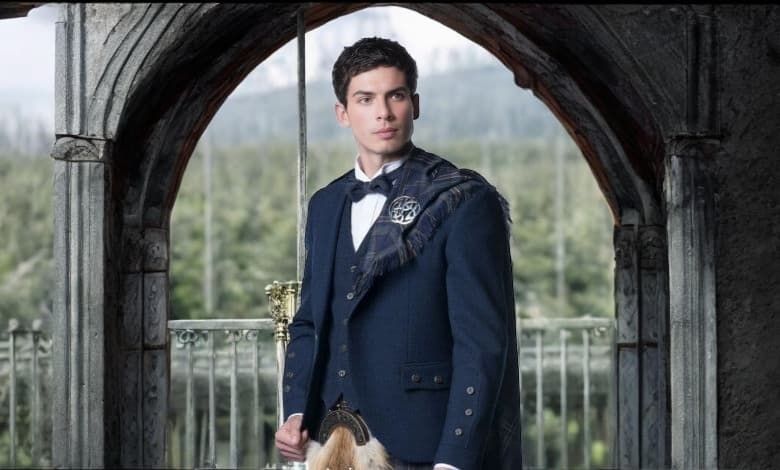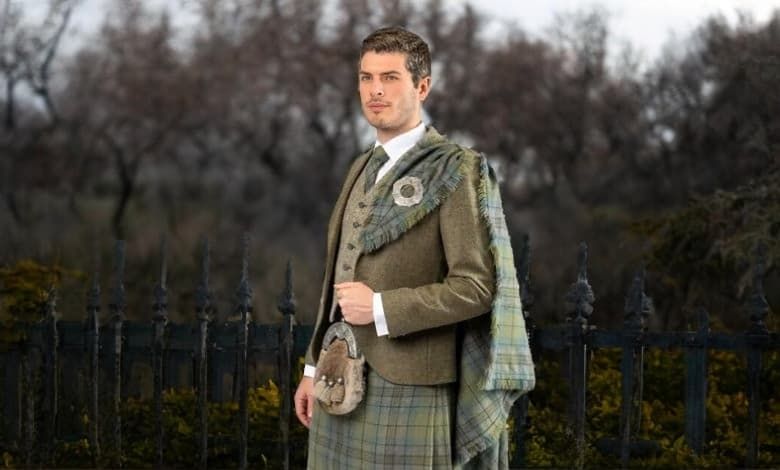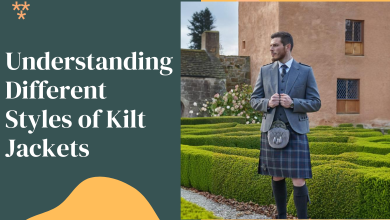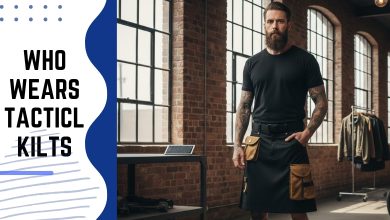Kilt Brooches: A Timeless Elegance of Kilt Outfit

A Scottish kilt outfit typically features many accessories. A kilt brooch or fly plaid brooch is the traditional one among them and used to hold a shoulder plaid to prevent it from falling. Moreover, the crest over this designed pin has several Scottish symbols such as thistle, Celtic knots, and Lion Rampant.
Many people confuse brooches with kilt pins. They should clear this misconception. Kilt pins are attached to the lower bottom of the kilt, while the brooch is pinned on the shoulder over the jackets. This article revolves around this particular item and aims to inform about its history to practical caring tips and more. Let’s start this discussion by digging out its origin.
Table of Contents
ToggleA Brief History and Cultural Significance of the Kilt Brooch
Every part of Scottish attire represents the culture. A kilt pin is the last addition to the outfit which occurred in Queen Victoria’s era. Fly plaid brooch, on the other hand, falls on the list of most ancient ones. It spiked with the emergence of Highland dress.
Studies claim its first usage with the great kilts, which was a long piece of fabric. Scots wrapped it around the lower part of the bodies, while the remaining fabric draped over the shoulder. It worked as both a blanket and shroud in different circumstances. The brooch was used then to hold the draped fabric.
The Role of the Brooch in Securing a Fly Plaid
A must-have item of Highland apparel is the fly plaid kilt brooch worn with the fly plaid. It supports the weight of the cloth and keeps it in place by fastening the fly plaid to the wearer’s shoulder. Furthermore, it promotes clan heritage and permits individual expression. Wearers can flaunt their history and individuality with a variety of brooch designs, which include thistle patterns, clan crests, and other Celtic elements.
Simple Steps to Attach a Plaid Brooch Securely

Attaching a kilt brooch to the jacket is an easy task. You have to securely attach a fly plaid brooch but following a few steps. Start with folding the plaid into a triangle shape in two adjacent corners towards each other. Then, secure the folded corner of your jacket at breast level using the brooch. The brooch’s pin should pass through the fabric of the plaid and into the jacket.
Fold the Plaid: Lay the plaid out flat and fold two adjacent corners towards each other, forming a triangle.
Prepare for the Brooch: Drape the plaid over your left shoulder, ideally through the epaulet if your jacket has one, or simply over the shoulder.
Attach the Brooch: Locate the folded corner of the plaid that is now on your front, near breast level. Open the brooch and pass the pin through the fabric of the plaid and into your jacket.
Secure the Brooch: Close the brooch to secure the plaid. The plaid should hang down just below the length of your kilt. You can make adjustments to the height by manipulating the folds of the plaid before securing the brooch.
Choosing the Right Brooch for Your Fly Plaid

Selecting a fly plaid brooch goes beyond a fashion choice. It reflects one’s tradition, event, and even the meaning behind a tartan. Let’s explore how to make the right pick without compromising on elegance or practicality.
Match the Brooch Style to the Occasion
Your brooch should blend nicely with the event’s theme. A brooch with elaborate Celtic designs, diamonds, or antique finishes emphasizes a regal appearance for formal events like weddings or Ceilidh. Casual or semi-formal gatherings are appropriate for simpler designs.
Select a Brooch That Complements Your Tartan Colors
A good brooch does not overshadow your tartan. Instead, it enhances the visual harmony. Look for metal finishes (silver, bronze, or pewter) that go well with your kilt’s dominant shades. Some brooches also include colored stones to blend with tartan hues.
Choose a Brooch with Sufficient Weight and Durability
The brooch should be light enough to hang naturally without damaging the jacket because it supports the fly plaid. To ensure its longevity, particularly during traditional dances or motions, it must also be constructed with durable materials.
Look for Secure and Sturdy Pin Mechanisms
An elegant brooch is of no use if its clasp gives way. Always check for a strong fastening pin that firmly secures the plaid to your shoulder. Safety clasps or rotating locks add an extra layer of reliability.
Reflect Your Clan, Heritage, or Personal Symbolism
Your brooch can convey identification, whether it’s a Lion Rampant, thistle, or a clan crest. To transform your clothing into both a style and a narrative, choose a design that has ancestors’ or personal significance. In addition, symbols like St. Andrew’s Cross and Celtic knots are proud references to Scotland’s past. By wearing these symbols, you may exhibit pride in your heritage and continue a legacy.
Brooch Styles and Materials: Traditional to Contemporary

Regarding the materials used to make a brooch, different metals including silver, brass, and stainless steel have been popular options. Therefore, the designs of this item can have several choices. They traditionally have different styles depending on event themes, clan crest, national symbols, etc.
Simple styles: Simple-styled plaid brooches are uncomplicated in appearance as their names represent. They usually have a ring shape or are rectangular, while sometimes decorated with stones.
Modern Styles: Proving their name right, modern brooches have different styles containing different symbols like stags, thistles, etc. Though they have traditional signs, apparent-wise they are modern ones.
Evening Wear: For formal occasions like weddings, the Highland Games, and Christmas celebrations, these brooches make excellent selections. A vital component of a full traditional Highland ensemble, they can come in a variety of patterns, sometimes including Celtic themes or clan crests.
Caring for and Maintaining Your Brooch
Though brooch acts as an important and supportive item of Scottish attire, keeping it clean is very important. Therefore, doing so is not challenging at all. The simple cleaning process starts with gently wiping the brooch’s surface with a soft, dry cloth to remove dust and dirt. Similarly, there is a strict demand to avoid harsh chemicals because they can damage its finish. Once cleaned thoroughly, you should consider storing it in a cool, dry place. Make sure that moisture and direct sunlight are not directly approaching them to prevent fading or corrosion.
Where to Buy a Quality Brooch
Finding the best among existing thousands of brands is challenging but we are here to introduce “The Utility Kilt” to you where you can buy everything from kilt brooches to kilts for men. Other than premium-made products, we care for everyone and ensure significant affordability for the ones who cannot afford costlier products. So, visit our online store today and find the best one that suits you!
FAQs About Fly Plaid Brooch
What is the difference between a clan crest brooch and a decorative brooch?
A clan crest brooch is specific to the people following the same clan, while decorative brooches are suitable for everyone. No matter what clan or ancestry a person has, he can wear a decorative brooch.
Can I wear a brooch from a different clan?
While clan brooches are associated with a particular clan, there is no prohibition for others to attach them.
Is it acceptable to wear modern or custom brooch designs?
There is no restriction in pairing a specific brooch variation and it is totally acceptable to wear a modern or a custom brooch design. Therefore, the event’s theme must be examined first and decided on.



